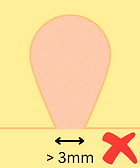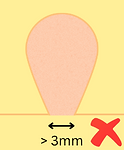
Haypark Business Centre, Marchmont Avenue, Polmont, Falkirk FK2 0NZ
WHAT WE TREAT
Who can attend
We welcome anyone that is able to travel to the clinic.
You need to be able to consent to the treatment.
Children are welcome and must be accompanied by a parent or legal guardian. Children must be aged 7 years and over.
What we treat
The Cryo Doctor is happy to treat the following benign skin lesions:
Warts
Verrucae
Skin tags
Seborrhoeic keratoses
Actinic (solar) keratoses
If your GP has referred you to this clinic, it is likely the treatment is appropriate for your lesion.
However, please read the information below to check you are suitable for treatment.
If you are unsure of the type of lesion you have, you can send us a photo by email or WhatsApp before booking and the doctor can give an opinion if it is treatable with cryotherapy.
Your consultation fee includes treatment of up to two lesions.
What we DO NOT treat
If the doctor is concerned the lesion is more serious, cryotherapy would not be appropriate and you will be asked to see your GP.
You are welcome to contact us if you are not sure or require more information.
We DO NOT treat
Moles (Naevi).
Cryotherapy does not work for moles. A pigmented naevus can easily be confused with a seborrhoeic keratosis. Moles have a soft fleshy feel compared to firmer seborrhoiec keratoses. A coloured naevus can be confused with a skin tag. You can send us a photo beforehand if you are not sure.

Large skin tags.
Treatment for large skin tags with a broad base can be unsuccessful.
As a guide, any skin tag with a base larger than 3mm at the narrowest part, is not likely to come off.
You are best seeing a surgeon to have these removed.

Molluscum Contagiosum.
These childhood warts will resolve on their own and cryotherapy is not necessary.
Click here for example photos if you are unsure what these are.
Viral Warts




These are common, are caused by a virus and can affect any age group. They commonly affect fingers, toes, next to nails and knees. Appearances can be variable depending on the specific type. They can be flat, rough, cauliflower-like or quite raised, and may have visible dark red / black dots with it.
Although unsightly, the majority of warts will resolve on their own within a few months but can be up to a few years for some.
Cryotherapy, in most cases, can significantly shorten the time to clear these lesions.
Click here to view more example photos from DermNetNZ.
Number of treatments
Typically 1 - 3 treatments for most warts
Larger ones can take longer
Time to resolve
Within 2 weeks of a treatment
Tips for success
If tolerated, rub the wart down with an emery board, file or sandpaper before each treatment
EXCEPTIONS
NO
molluscum contagiosum
or
genital warts
Verrucae




Also known as "plantar warts".
These are warts of the soles of the feet and caused by a virus. They are commonly painful, especially with pressure when walking. Small dark red or black dots within it can help you identify these.
Salicylic acid paints, duct tape, banana peel and over the counter freeze kits are commonly tried home remedies that vary in success.
If you have found these ineffective, a session of cryotherapy may be noticeably better.
Like all viral warts, if left alone, verrucae should resolve on their own but can take months to do so. Depending on the size of the verruca, cryotherapy can clear the lesion after one treatment or more treatments.
Click here to view more example photos from DermNetNZ.
A cluster counts as 'one' lesion for treatment.
Number of treatments
Typically 1 - 3 treatments for most verrucae
Verrucae can be quite stubborn and larger ones can take longer
Time to resolve
Within 2 weeks of a treatment
Tips for success
Soak and rub down hard skin as much as possible with an emery board, pumice, file or sandpaper before each treatment
EXCEPTIONS
CORNS are not the same as verrucae. These are just thickened areas of skin caused by friction. See a podiatrist for these.
Skin tags




These are fleshy skin coloured lesions that can appear in several places on the body. The exact cause is not known. They can be numerous and may be in awkward places e.g. the neck, armpits, chest and back. They can catch on clothing and jewellery causing tearing and sometimes bleeding.
The best skin tags for successful treatment are those that are small, slim and hang on a stalk.
Larger and broad based skin tags (greater than 3mm at the narrowest part) may resist.
Please ask us before booking for these e.g. send us a photo.
Click here to view more example photos from DermNetNZ.
Number of treatments
Usually 1 treatment
A free repeat treatment can be offered if it didn't work first time
Time to resolve
Within 1 week
Larger ones can take up to 2 weeks
Tips for success
Small tags that hang off a stalk are the most successful

Please send a photo of large tags before booking
EXCEPTIONS
NO MOLES
Narrow stalk
Round wide base

Seborrhoeic keratoses




Also known as “seborrhoeic warts” and “senile warts” and “basal cell papilloma”.
Seborrhoeic keratoses are a sign of the ageing process and are very common. They can appear anywhere on the body. The exact cause is unknown. They have a variable appearance and texture, from brown to fleshy coloured, and from smooth to rough. People can find them unsightly or itchy, especially when catching on clothing. They are harmless but for particularly annoying ones, cryotherapy can remove these effectively.
Click here for more example photos from DermNetNZ.
Number of treatments
Typically 1 treatment. Occasionally twice.
Time to resolve
Within 2 weeks of a treatment
Thicker ones can take up to 6 weeks
Tips for success
Thicker ones might take more than one treatment
EXCEPTIONS
NO MOLES
Firm
Soft
